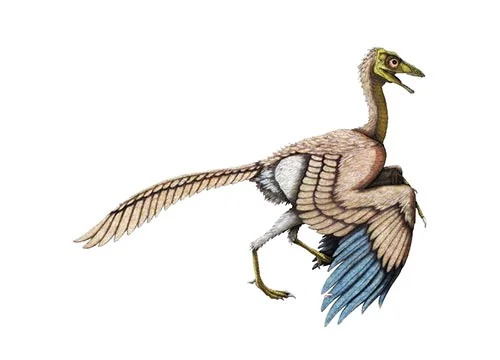Archaeopteryx (Ancient wing)

Ar-kay-op-teh-rix
Christian Erich Hermann von Meyer - 1861
Carnivore / Insectivore
Estimated 50cm meters long
Small Theropod
A. lithographica (type) A. albersdoerferi
Various locations in Germany
Late Jurassic, 147 million years ago
Archaeopteryx Facts
Archaeopteryx is a genus of feathered dinosaurs that lived during the Late Jurassic period, approximately 150 million years ago. The genus contains a single species, Archaeopteryx lithographica, which was first discovered in the late 1850s in the Solnhofen limestone formations of Germany.
Archaeopteryx was a small dinosaur, estimated to have measured between 30 to 50 centimeters in length and weighed between 0.5 to 1 kilogram. Despite its small size, Archaeopteryx was a unique dinosaur, with both avian and reptilian characteristics. It had a large, bony tail, and long, slender arms with claws, which were typical of reptiles. However, it also had feathers, which are a defining characteristic of birds.
The feathers of Archaeopteryx are of great significance, as they provide the earliest evidence of feather evolution and the origin of flight in birds. The feathers were symmetrical, with a central shaft and vanes on either side, which indicates that they were used for flight. Additionally, the presence of feathers on the arms and legs of Archaeopteryx suggests that they were used for thermal regulation and insulation.
In terms of geographical distribution, Archaeopteryx is known only from the Solnhofen limestone formations of Germany, which was once a shallow sea that was rich in marine life. The discovery of Archaeopteryx in this region provides important information about the evolution of birds and the fauna of the Late Jurassic period in Europe.
Archaeopteryx is a significant dinosaur genus for several reasons. Firstly, it is one of the earliest known birds, and its discovery sheds light on the evolution and diversification of this group of animals. Secondly, its unique anatomy, including the feathers and bony tail, provides insights into the adaptations and ecological roles of early birds. Finally, the presence of Archaeopteryx in the Solnhofen limestone formations highlights the importance of this region for the study of dinosaur evolution and diversity.
In conclusion, Archaeopteryx is a fascinating dinosaur species that provides valuable insights into the evolution and ecology of birds and the fauna of the Late Jurassic period in Europe. I hope this brief overview has sparked your interest in this amazing dinosaur genus, and I encourage you to learn more about its discovery, anatomy, and significance.



